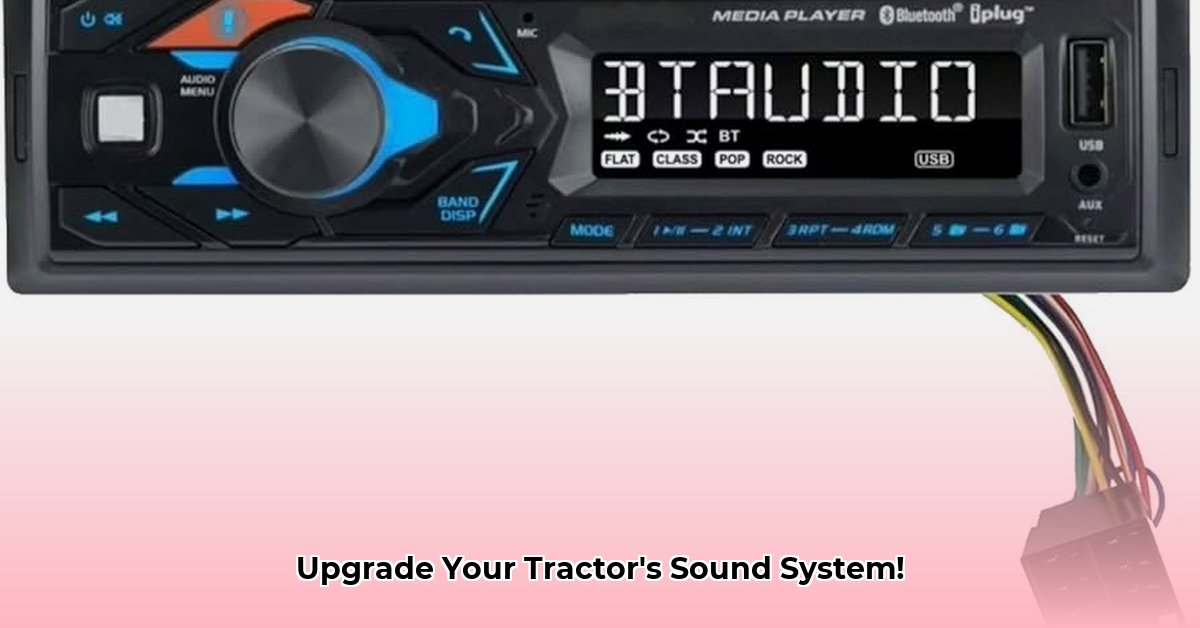
Imagine this: you're deep in the field, a crucial delivery is running late, and your tractor radio dies. No communication. In today's agriculture, a reliable tractor radio isn't a luxury—it's essential for efficient operations and safety. This guide helps you choose, install, and maintain the perfect radio for your farm. We'll cover everything from comparing models to troubleshooting common issues, ensuring you stay connected and productive.
Navigating the World of Tractor Radios
The market offers various options: basic AM/FM units, advanced models with Bluetooth, and high-tech radios with weather alerts. Choosing the right one is crucial for productivity and safety. Durability is a key factor; your radio needs to withstand dust, bumps, and extreme weather. Many newer models offer “plug-and-play” installation, simplifying the process for busy farmers. However, understanding your needs and options is key to making the right choice.
Finding Your Perfect Farm Radio Match
Selecting the right radio involves several key considerations. This personalized approach ensures the device fits your farming environment perfectly.
Key Factors to Consider:
- Tractor Type and Size: Compatibility is paramount. Check your tractor's manual or consult your dealer to ensure a proper fit. Incorrect choices lead to wasted time and money.
- Usage Intensity: Daily use demands a more robust radio than occasional use. Heavy usage requires durability and reliability above all else.
- Desired Features: Do you need basic AM/FM, or are Bluetooth, weather alerts, or auxiliary inputs important? Prioritize features based on your needs.
- Budget: Tractor radios vary widely in price. Set a realistic budget to avoid overspending.
| Feature | Basic Model | Mid-Range Model | Premium Model |
|---|---|---|---|
| Power Output (Watts) | 10-20 | 20-50 | 50+ |
| Durability | Weather-resistant | Shock and vibration resistant | Fully waterproof and extreme temperature resistant |
| Key Features | AM/FM | AM/FM, Aux input, Bluetooth | AM/FM, Aux input, Bluetooth, Weather Alerts, USB charging |
| Approximate Price Range ($) | $50-$150 | $150-$300 | $300+ |
Compatibility Check: Always verify compatibility with your tractor before purchasing to avoid costly mistakes.
Installing Your New Tractor Radio: A Step-by-Step Guide
Installation can be a quick trip to the dealer or a DIY project. Both options have advantages and disadvantages.
Option 1: Professional Installation
- Schedule an Appointment: Most dealerships offer installation services. This is the easiest option, but it comes with a service fee.
- Installation: The professionals handle wiring and testing.
- Enjoy Your Radio: Your new radio is ready to use.
Option 2: DIY Installation
- Safety First: Disconnect the battery to prevent electric shocks.
- Choose a Mounting Location: Select a secure, accessible location that doesn't obstruct any tractor controls.
- Wiring: Carefully follow the radio's installation manual. Take your time to avoid mistakes.
- Connect Components: Securely fasten all connections.
- Reconnect the Battery: Once everything is connected, reconnect the battery and test the functionality.
- Troubleshooting: If issues arise, double-check connections and consult the manual.
Keeping Your Tractor Radio in Top Shape
Regular maintenance extends your radio's lifespan and ensures reliable performance.
- Regular Cleaning: Remove dust and debris with a damp cloth.
- Wiring Inspection: Regularly check for damaged wires.
- Consult the Manual: Refer to the manufacturer's instructions for specific maintenance advice.
Remember: A reliable communication system is vital. A functioning tractor radio enhances productivity, improves safety, and keeps you connected. Contact your dealer or equipment supplier for additional assistance.
Choosing the Best Pre-Wired Farm Tractor Radio: A Summary
Selecting the right radio depends on your specific needs and tractor model. Prioritize compatibility, durability, and desired features. Thorough research before purchase saves time and frustration. Consider professional installation if you are not comfortable with DIY projects.